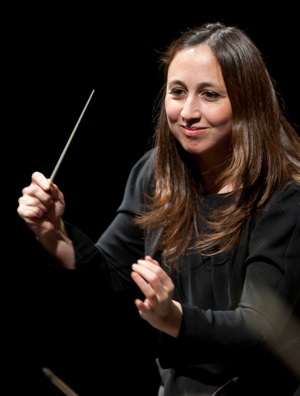Of cowbells and onion domes – Carneiro leads Berkeley Symphony in “Sanctuary”
A program of colors and contrasts showcased the skill and unity of the Berkeley Symphony last Thursday at Zellerbach Hall. As always, conductor Joana Carneiro delivered insight, exactitude and heart, drawing the audience firmly into the music along with her musicians.
Titled “Sanctuary,” the program painted two very different musical portraits. Asyla, written by British composer Thomas Adès when he was just 26 years old, is a brash tale of heady textures and dense rhythms. Following that, Tchaikovsky’s Symphony No. 6, the “Pathétique,” condensed layers of lush and stern, sweetness and sorrow, for a work that premiered nine days before that great composer died of cholera.
I was continually surprised by how tight the Berkeley Symphony sounded, especially after only the requisite four rehearsals (packed into three days including the concert!) but their delivery was edge-of-the-seat stuff.
 Carneiro took the mike to greet us. “This program is about contrast. Asyla, the plural of asylum, is a duality of concepts. It is a place of refuge and also a place of insanity. One can hear both here. And Pathétique is a piece full of passion.”
Carneiro took the mike to greet us. “This program is about contrast. Asyla, the plural of asylum, is a duality of concepts. It is a place of refuge and also a place of insanity. One can hear both here. And Pathétique is a piece full of passion.”
Adès came to San Francisco in 2007 to perform his own work and that of Janáček and other twentieth century composers. His short themes and busy deconstructions, like those of Janáček, seemed in evidence even in this early work.
But this was not “easy” music. Extended techniques and dense layering substituted for melody, but with moments of supreme clarity and textures of surprising delicacy. The British magazine 5:4 says of Asyla, “It’s the most beautiful ugly sound in the world.” Once one becomes accustomed to this eclectic abecedary, we find a beguiling and purposeful language.
Marimba and cowbells, played by Ward Spangler, seemed to spell the underlying tension between tonal and atonal languages and between pitch centers and the slack thud of percussion. The bells contain a clear tone in the midst of their own clangor, an odyssey in which notes sail on un-chartable waveforms. (Yes, Christopher Walken. “Give me more cowbells!”)
In this composer’s refuge and pandemonium, trumpets sent up brays and squeals, beasts in a restless jungle. Sharp bat-cries of piccolo harassed the top registers, oboes paddled swan-like through the center, and low violas and deep gongs created a vibrant unease.
A wistful pavane followed; slow descending figures that built into stately ice floes, and stretching from high harmonics down into deep contrabassoon. Then rhythms replaced textures in the third movement, “Ecstasia,” an unexpected turn into head-banging turf, before subsiding into tubular bells and serene dissonances.
This mouthy and turbulent work may not have needed all of its bells and whistles to make a case, but it was unique.
And then after intermission they switched to melodic and Romantic. Tchaikovsky’s blend of French colors and Russian scales painted sweeping emotions from the third movement triumph to the final tragedy. Muscular horns and lonely clarinet were the order of the night, with mournful violas every bit as passionate as Carneiro implied. Perhaps having that immensely difficult modern work as a preface pushed the musicians to an extreme of attention. Or perhaps it was Carneiro’s own passion that so transported us.
Bravely done.
—Adam Broner
Photo of Joana Carneiro; photo by Dave Weiland.
